Torts in Business: Negligence, Misrepresentation, and Legal Aspects
VerifiedAdded on 2020/04/01
|8
|2365
|378
Report
AI Summary
This report provides a detailed analysis of the torts of negligence and misrepresentation as they apply to business situations. It begins by defining negligence, outlining the elements required for a successful claim, and providing real-world examples such as car accidents and medical malpractice. The report also discusses the concept of breach of duty, the standard of care, and contributory negligence. Furthermore, the report explores misrepresentation, distinguishing between statements of fact and opinion, and examining fraudulent and innocent misrepresentation. It also covers remedies such as rescinding a contract and seeking compensation. The report concludes by summarizing the legal principles and practical implications of these torts in a business context.
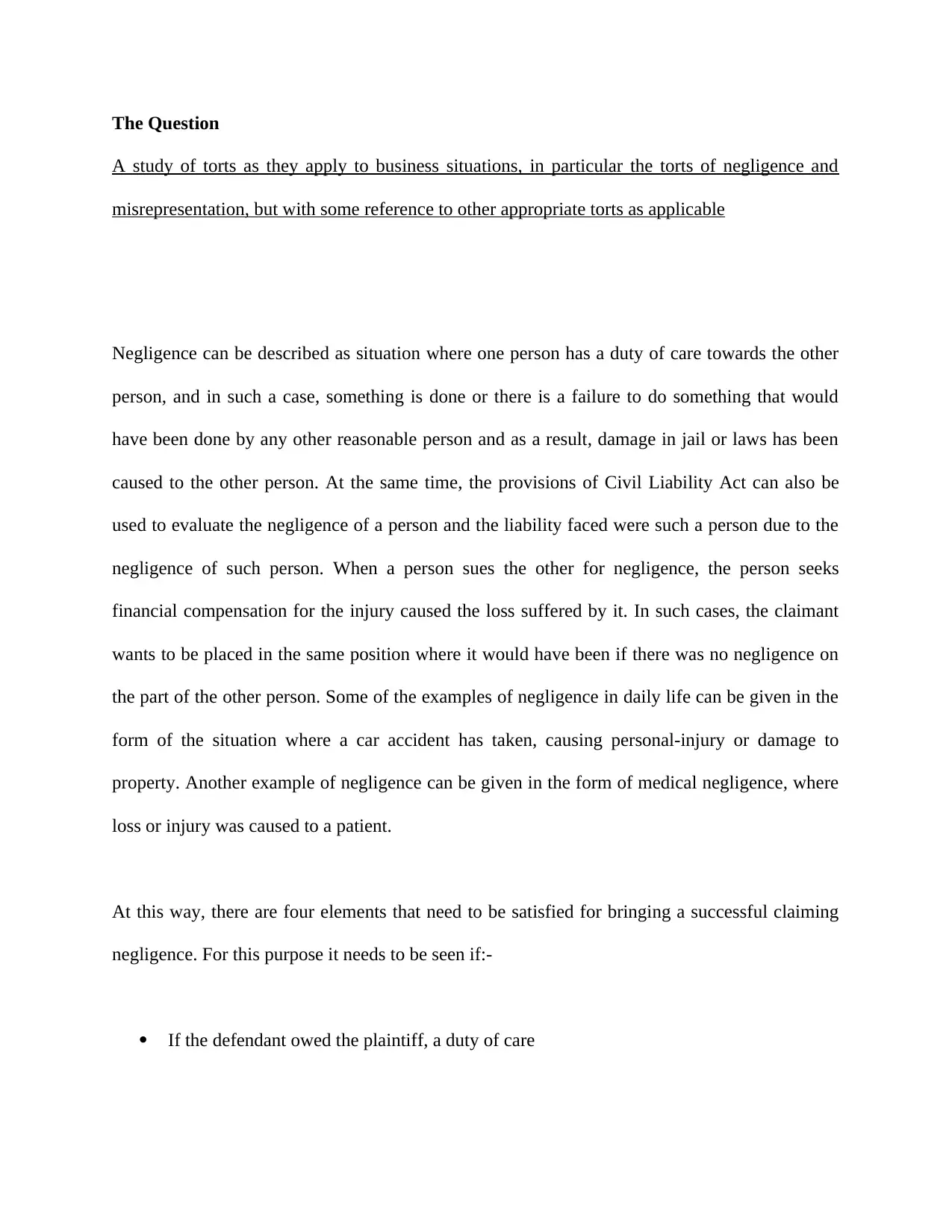
The Question
A study of torts as they apply to business situations, in particular the torts of negligence and
misrepresentation, but with some reference to other appropriate torts as applicable
Negligence can be described as situation where one person has a duty of care towards the other
person, and in such a case, something is done or there is a failure to do something that would
have been done by any other reasonable person and as a result, damage in jail or laws has been
caused to the other person. At the same time, the provisions of Civil Liability Act can also be
used to evaluate the negligence of a person and the liability faced were such a person due to the
negligence of such person. When a person sues the other for negligence, the person seeks
financial compensation for the injury caused the loss suffered by it. In such cases, the claimant
wants to be placed in the same position where it would have been if there was no negligence on
the part of the other person. Some of the examples of negligence in daily life can be given in the
form of the situation where a car accident has taken, causing personal-injury or damage to
property. Another example of negligence can be given in the form of medical negligence, where
loss or injury was caused to a patient.
At this way, there are four elements that need to be satisfied for bringing a successful claiming
negligence. For this purpose it needs to be seen if:-
If the defendant owed the plaintiff, a duty of care
A study of torts as they apply to business situations, in particular the torts of negligence and
misrepresentation, but with some reference to other appropriate torts as applicable
Negligence can be described as situation where one person has a duty of care towards the other
person, and in such a case, something is done or there is a failure to do something that would
have been done by any other reasonable person and as a result, damage in jail or laws has been
caused to the other person. At the same time, the provisions of Civil Liability Act can also be
used to evaluate the negligence of a person and the liability faced were such a person due to the
negligence of such person. When a person sues the other for negligence, the person seeks
financial compensation for the injury caused the loss suffered by it. In such cases, the claimant
wants to be placed in the same position where it would have been if there was no negligence on
the part of the other person. Some of the examples of negligence in daily life can be given in the
form of the situation where a car accident has taken, causing personal-injury or damage to
property. Another example of negligence can be given in the form of medical negligence, where
loss or injury was caused to a patient.
At this way, there are four elements that need to be satisfied for bringing a successful claiming
negligence. For this purpose it needs to be seen if:-
If the defendant owed the plaintiff, a duty of care
Paraphrase This Document
Need a fresh take? Get an instant paraphrase of this document with our AI Paraphraser
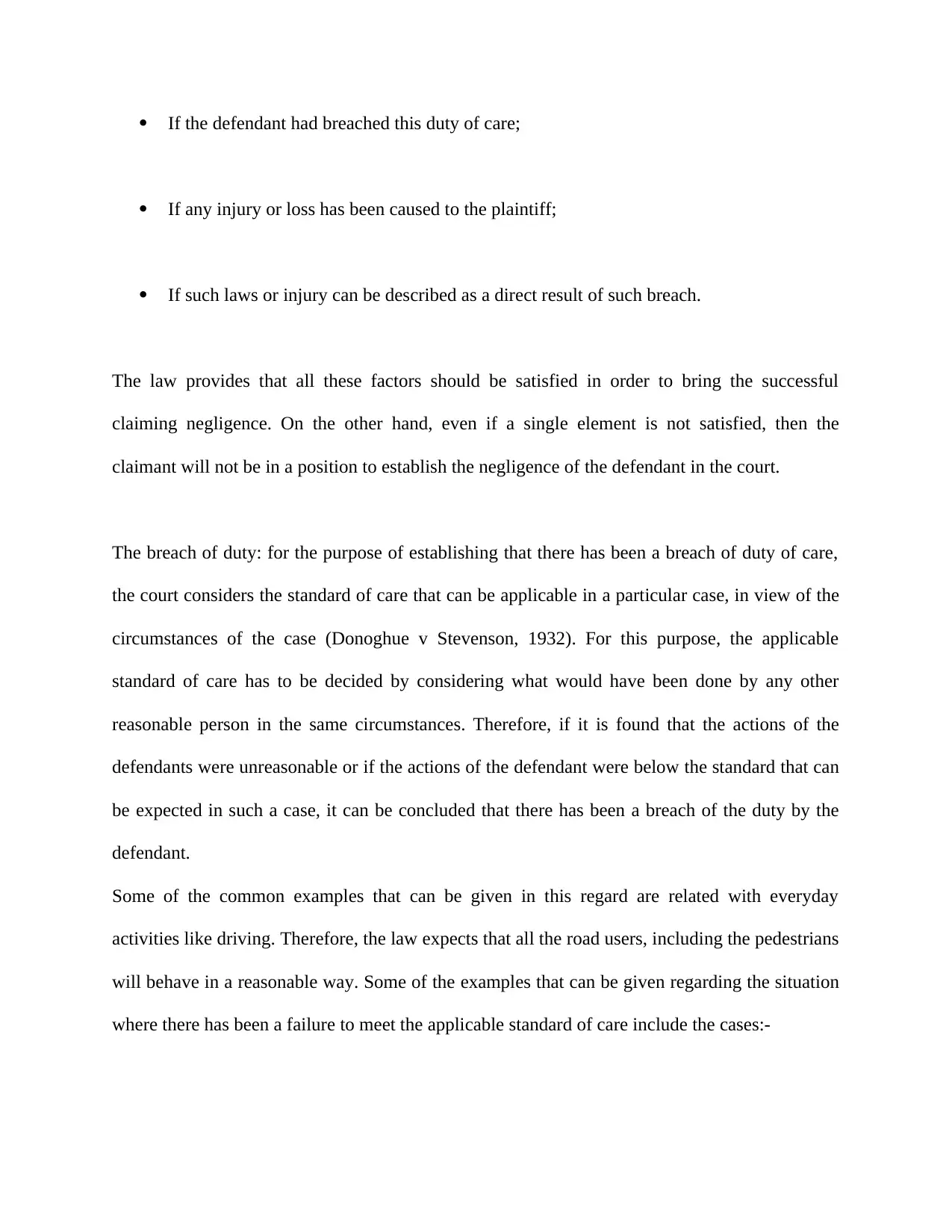
If the defendant had breached this duty of care;
If any injury or loss has been caused to the plaintiff;
If such laws or injury can be described as a direct result of such breach.
The law provides that all these factors should be satisfied in order to bring the successful
claiming negligence. On the other hand, even if a single element is not satisfied, then the
claimant will not be in a position to establish the negligence of the defendant in the court.
The breach of duty: for the purpose of establishing that there has been a breach of duty of care,
the court considers the standard of care that can be applicable in a particular case, in view of the
circumstances of the case (Donoghue v Stevenson, 1932). For this purpose, the applicable
standard of care has to be decided by considering what would have been done by any other
reasonable person in the same circumstances. Therefore, if it is found that the actions of the
defendants were unreasonable or if the actions of the defendant were below the standard that can
be expected in such a case, it can be concluded that there has been a breach of the duty by the
defendant.
Some of the common examples that can be given in this regard are related with everyday
activities like driving. Therefore, the law expects that all the road users, including the pedestrians
will behave in a reasonable way. Some of the examples that can be given regarding the situation
where there has been a failure to meet the applicable standard of care include the cases:-
If any injury or loss has been caused to the plaintiff;
If such laws or injury can be described as a direct result of such breach.
The law provides that all these factors should be satisfied in order to bring the successful
claiming negligence. On the other hand, even if a single element is not satisfied, then the
claimant will not be in a position to establish the negligence of the defendant in the court.
The breach of duty: for the purpose of establishing that there has been a breach of duty of care,
the court considers the standard of care that can be applicable in a particular case, in view of the
circumstances of the case (Donoghue v Stevenson, 1932). For this purpose, the applicable
standard of care has to be decided by considering what would have been done by any other
reasonable person in the same circumstances. Therefore, if it is found that the actions of the
defendants were unreasonable or if the actions of the defendant were below the standard that can
be expected in such a case, it can be concluded that there has been a breach of the duty by the
defendant.
Some of the common examples that can be given in this regard are related with everyday
activities like driving. Therefore, the law expects that all the road users, including the pedestrians
will behave in a reasonable way. Some of the examples that can be given regarding the situation
where there has been a failure to meet the applicable standard of care include the cases:-
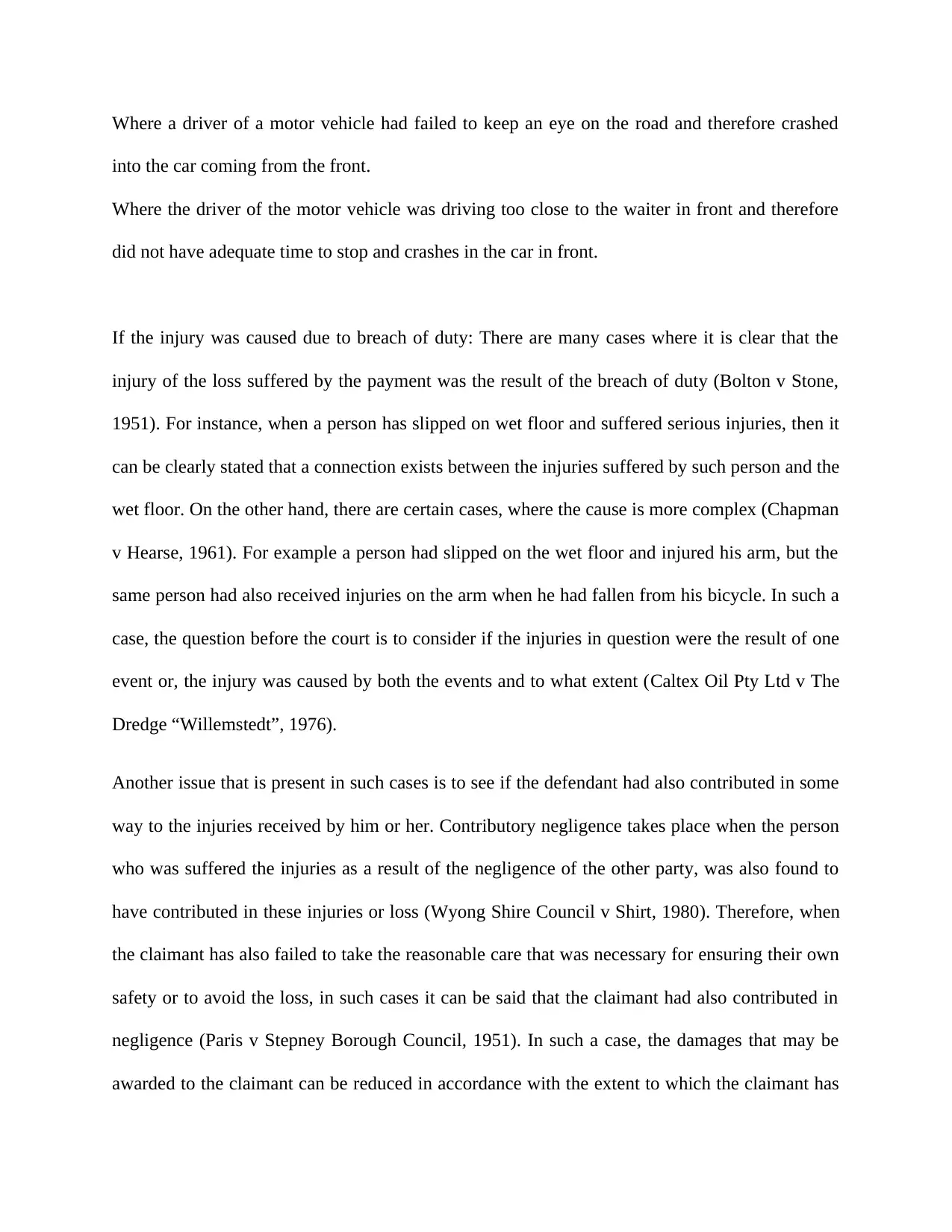
Where a driver of a motor vehicle had failed to keep an eye on the road and therefore crashed
into the car coming from the front.
Where the driver of the motor vehicle was driving too close to the waiter in front and therefore
did not have adequate time to stop and crashes in the car in front.
If the injury was caused due to breach of duty: There are many cases where it is clear that the
injury of the loss suffered by the payment was the result of the breach of duty (Bolton v Stone,
1951). For instance, when a person has slipped on wet floor and suffered serious injuries, then it
can be clearly stated that a connection exists between the injuries suffered by such person and the
wet floor. On the other hand, there are certain cases, where the cause is more complex (Chapman
v Hearse, 1961). For example a person had slipped on the wet floor and injured his arm, but the
same person had also received injuries on the arm when he had fallen from his bicycle. In such a
case, the question before the court is to consider if the injuries in question were the result of one
event or, the injury was caused by both the events and to what extent (Caltex Oil Pty Ltd v The
Dredge “Willemstedt”, 1976).
Another issue that is present in such cases is to see if the defendant had also contributed in some
way to the injuries received by him or her. Contributory negligence takes place when the person
who was suffered the injuries as a result of the negligence of the other party, was also found to
have contributed in these injuries or loss (Wyong Shire Council v Shirt, 1980). Therefore, when
the claimant has also failed to take the reasonable care that was necessary for ensuring their own
safety or to avoid the loss, in such cases it can be said that the claimant had also contributed in
negligence (Paris v Stepney Borough Council, 1951). In such a case, the damages that may be
awarded to the claimant can be reduced in accordance with the extent to which the claimant has
into the car coming from the front.
Where the driver of the motor vehicle was driving too close to the waiter in front and therefore
did not have adequate time to stop and crashes in the car in front.
If the injury was caused due to breach of duty: There are many cases where it is clear that the
injury of the loss suffered by the payment was the result of the breach of duty (Bolton v Stone,
1951). For instance, when a person has slipped on wet floor and suffered serious injuries, then it
can be clearly stated that a connection exists between the injuries suffered by such person and the
wet floor. On the other hand, there are certain cases, where the cause is more complex (Chapman
v Hearse, 1961). For example a person had slipped on the wet floor and injured his arm, but the
same person had also received injuries on the arm when he had fallen from his bicycle. In such a
case, the question before the court is to consider if the injuries in question were the result of one
event or, the injury was caused by both the events and to what extent (Caltex Oil Pty Ltd v The
Dredge “Willemstedt”, 1976).
Another issue that is present in such cases is to see if the defendant had also contributed in some
way to the injuries received by him or her. Contributory negligence takes place when the person
who was suffered the injuries as a result of the negligence of the other party, was also found to
have contributed in these injuries or loss (Wyong Shire Council v Shirt, 1980). Therefore, when
the claimant has also failed to take the reasonable care that was necessary for ensuring their own
safety or to avoid the loss, in such cases it can be said that the claimant had also contributed in
negligence (Paris v Stepney Borough Council, 1951). In such a case, the damages that may be
awarded to the claimant can be reduced in accordance with the extent to which the claimant has
⊘ This is a preview!⊘
Do you want full access?
Subscribe today to unlock all pages.

Trusted by 1+ million students worldwide
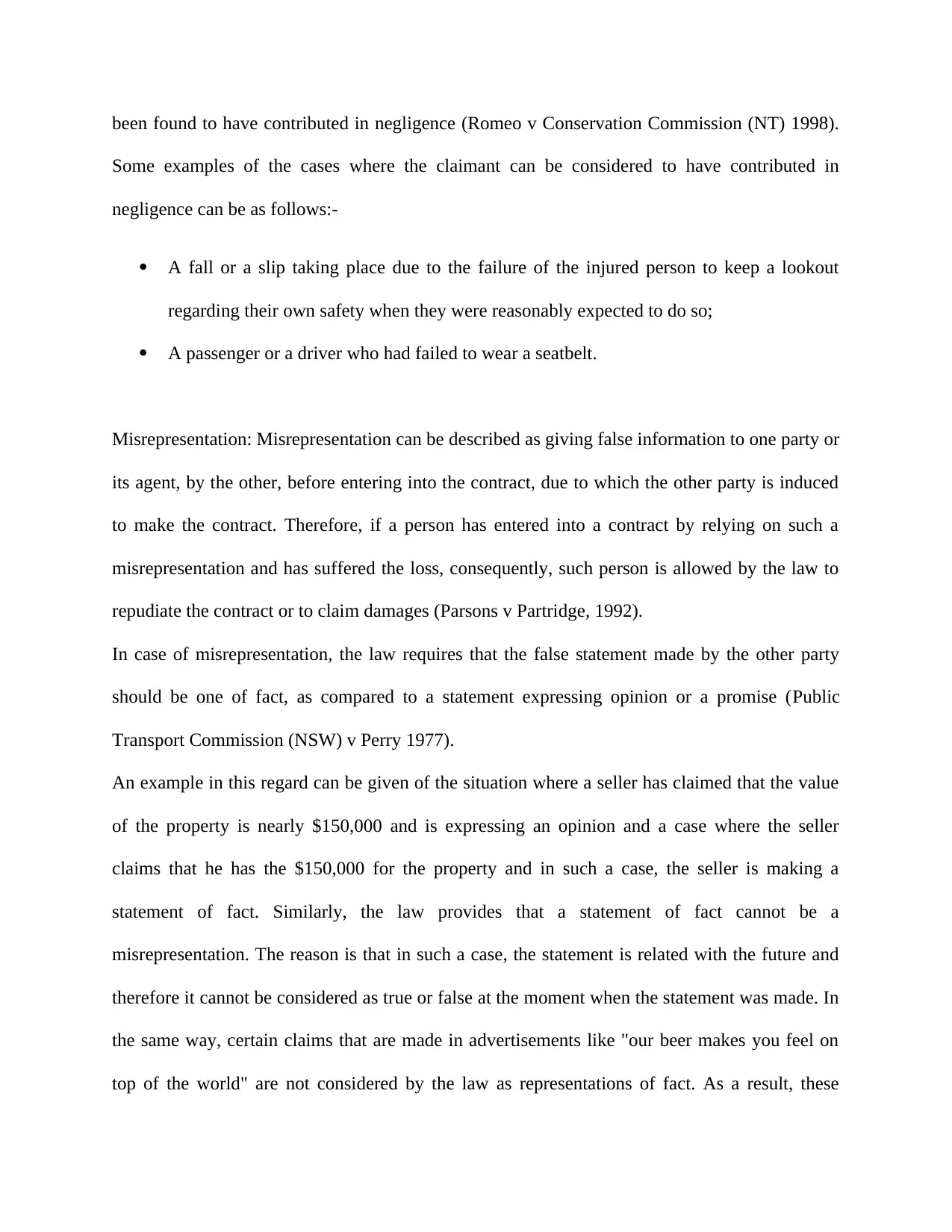
been found to have contributed in negligence (Romeo v Conservation Commission (NT) 1998).
Some examples of the cases where the claimant can be considered to have contributed in
negligence can be as follows:-
A fall or a slip taking place due to the failure of the injured person to keep a lookout
regarding their own safety when they were reasonably expected to do so;
A passenger or a driver who had failed to wear a seatbelt.
Misrepresentation: Misrepresentation can be described as giving false information to one party or
its agent, by the other, before entering into the contract, due to which the other party is induced
to make the contract. Therefore, if a person has entered into a contract by relying on such a
misrepresentation and has suffered the loss, consequently, such person is allowed by the law to
repudiate the contract or to claim damages (Parsons v Partridge, 1992).
In case of misrepresentation, the law requires that the false statement made by the other party
should be one of fact, as compared to a statement expressing opinion or a promise (Public
Transport Commission (NSW) v Perry 1977).
An example in this regard can be given of the situation where a seller has claimed that the value
of the property is nearly $150,000 and is expressing an opinion and a case where the seller
claims that he has the $150,000 for the property and in such a case, the seller is making a
statement of fact. Similarly, the law provides that a statement of fact cannot be a
misrepresentation. The reason is that in such a case, the statement is related with the future and
therefore it cannot be considered as true or false at the moment when the statement was made. In
the same way, certain claims that are made in advertisements like "our beer makes you feel on
top of the world" are not considered by the law as representations of fact. As a result, these
Some examples of the cases where the claimant can be considered to have contributed in
negligence can be as follows:-
A fall or a slip taking place due to the failure of the injured person to keep a lookout
regarding their own safety when they were reasonably expected to do so;
A passenger or a driver who had failed to wear a seatbelt.
Misrepresentation: Misrepresentation can be described as giving false information to one party or
its agent, by the other, before entering into the contract, due to which the other party is induced
to make the contract. Therefore, if a person has entered into a contract by relying on such a
misrepresentation and has suffered the loss, consequently, such person is allowed by the law to
repudiate the contract or to claim damages (Parsons v Partridge, 1992).
In case of misrepresentation, the law requires that the false statement made by the other party
should be one of fact, as compared to a statement expressing opinion or a promise (Public
Transport Commission (NSW) v Perry 1977).
An example in this regard can be given of the situation where a seller has claimed that the value
of the property is nearly $150,000 and is expressing an opinion and a case where the seller
claims that he has the $150,000 for the property and in such a case, the seller is making a
statement of fact. Similarly, the law provides that a statement of fact cannot be a
misrepresentation. The reason is that in such a case, the statement is related with the future and
therefore it cannot be considered as true or false at the moment when the statement was made. In
the same way, certain claims that are made in advertisements like "our beer makes you feel on
top of the world" are not considered by the law as representations of fact. As a result, these
Paraphrase This Document
Need a fresh take? Get an instant paraphrase of this document with our AI Paraphraser
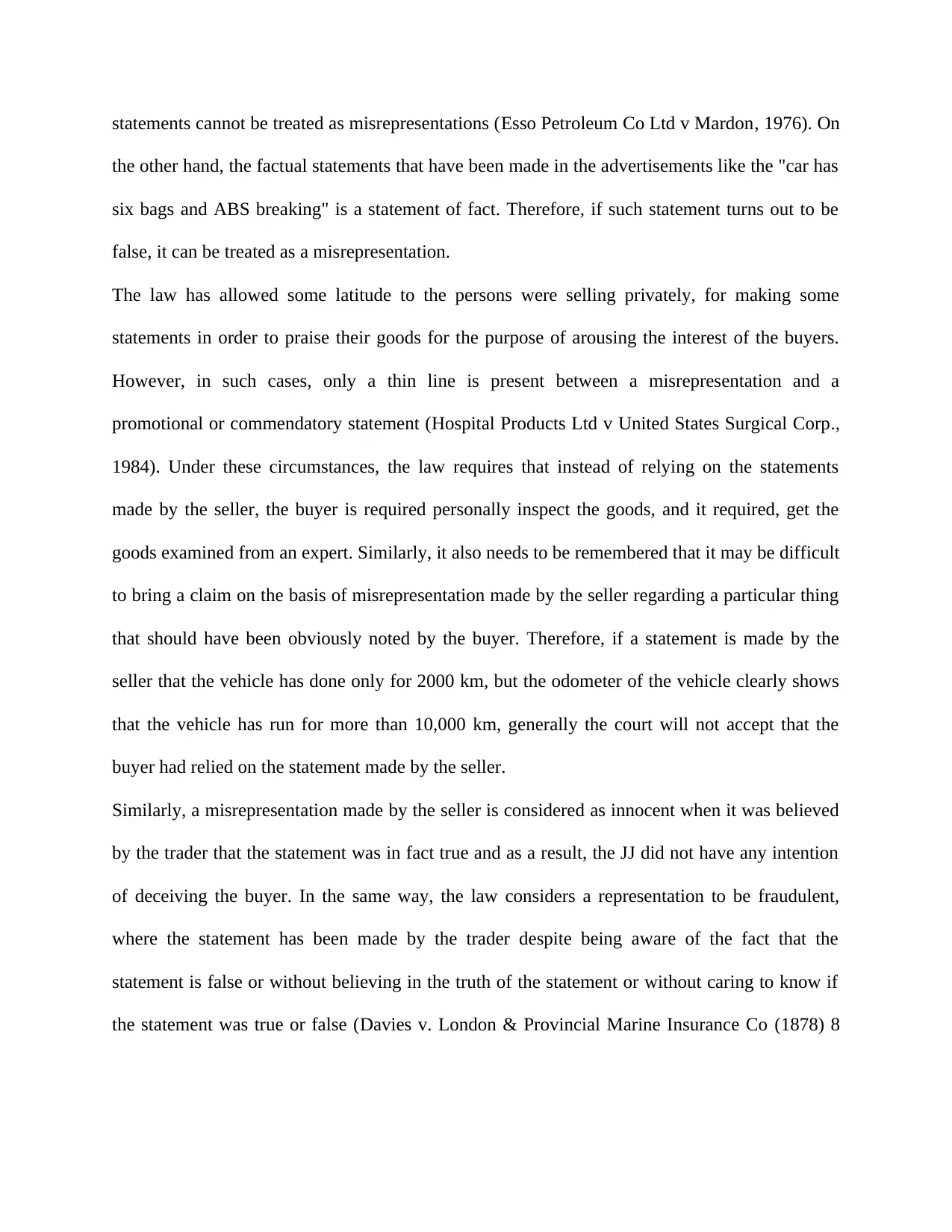
statements cannot be treated as misrepresentations (Esso Petroleum Co Ltd v Mardon, 1976). On
the other hand, the factual statements that have been made in the advertisements like the "car has
six bags and ABS breaking" is a statement of fact. Therefore, if such statement turns out to be
false, it can be treated as a misrepresentation.
The law has allowed some latitude to the persons were selling privately, for making some
statements in order to praise their goods for the purpose of arousing the interest of the buyers.
However, in such cases, only a thin line is present between a misrepresentation and a
promotional or commendatory statement (Hospital Products Ltd v United States Surgical Corp.,
1984). Under these circumstances, the law requires that instead of relying on the statements
made by the seller, the buyer is required personally inspect the goods, and it required, get the
goods examined from an expert. Similarly, it also needs to be remembered that it may be difficult
to bring a claim on the basis of misrepresentation made by the seller regarding a particular thing
that should have been obviously noted by the buyer. Therefore, if a statement is made by the
seller that the vehicle has done only for 2000 km, but the odometer of the vehicle clearly shows
that the vehicle has run for more than 10,000 km, generally the court will not accept that the
buyer had relied on the statement made by the seller.
Similarly, a misrepresentation made by the seller is considered as innocent when it was believed
by the trader that the statement was in fact true and as a result, the JJ did not have any intention
of deceiving the buyer. In the same way, the law considers a representation to be fraudulent,
where the statement has been made by the trader despite being aware of the fact that the
statement is false or without believing in the truth of the statement or without caring to know if
the statement was true or false (Davies v. London & Provincial Marine Insurance Co (1878) 8
the other hand, the factual statements that have been made in the advertisements like the "car has
six bags and ABS breaking" is a statement of fact. Therefore, if such statement turns out to be
false, it can be treated as a misrepresentation.
The law has allowed some latitude to the persons were selling privately, for making some
statements in order to praise their goods for the purpose of arousing the interest of the buyers.
However, in such cases, only a thin line is present between a misrepresentation and a
promotional or commendatory statement (Hospital Products Ltd v United States Surgical Corp.,
1984). Under these circumstances, the law requires that instead of relying on the statements
made by the seller, the buyer is required personally inspect the goods, and it required, get the
goods examined from an expert. Similarly, it also needs to be remembered that it may be difficult
to bring a claim on the basis of misrepresentation made by the seller regarding a particular thing
that should have been obviously noted by the buyer. Therefore, if a statement is made by the
seller that the vehicle has done only for 2000 km, but the odometer of the vehicle clearly shows
that the vehicle has run for more than 10,000 km, generally the court will not accept that the
buyer had relied on the statement made by the seller.
Similarly, a misrepresentation made by the seller is considered as innocent when it was believed
by the trader that the statement was in fact true and as a result, the JJ did not have any intention
of deceiving the buyer. In the same way, the law considers a representation to be fraudulent,
where the statement has been made by the trader despite being aware of the fact that the
statement is false or without believing in the truth of the statement or without caring to know if
the statement was true or false (Davies v. London & Provincial Marine Insurance Co (1878) 8
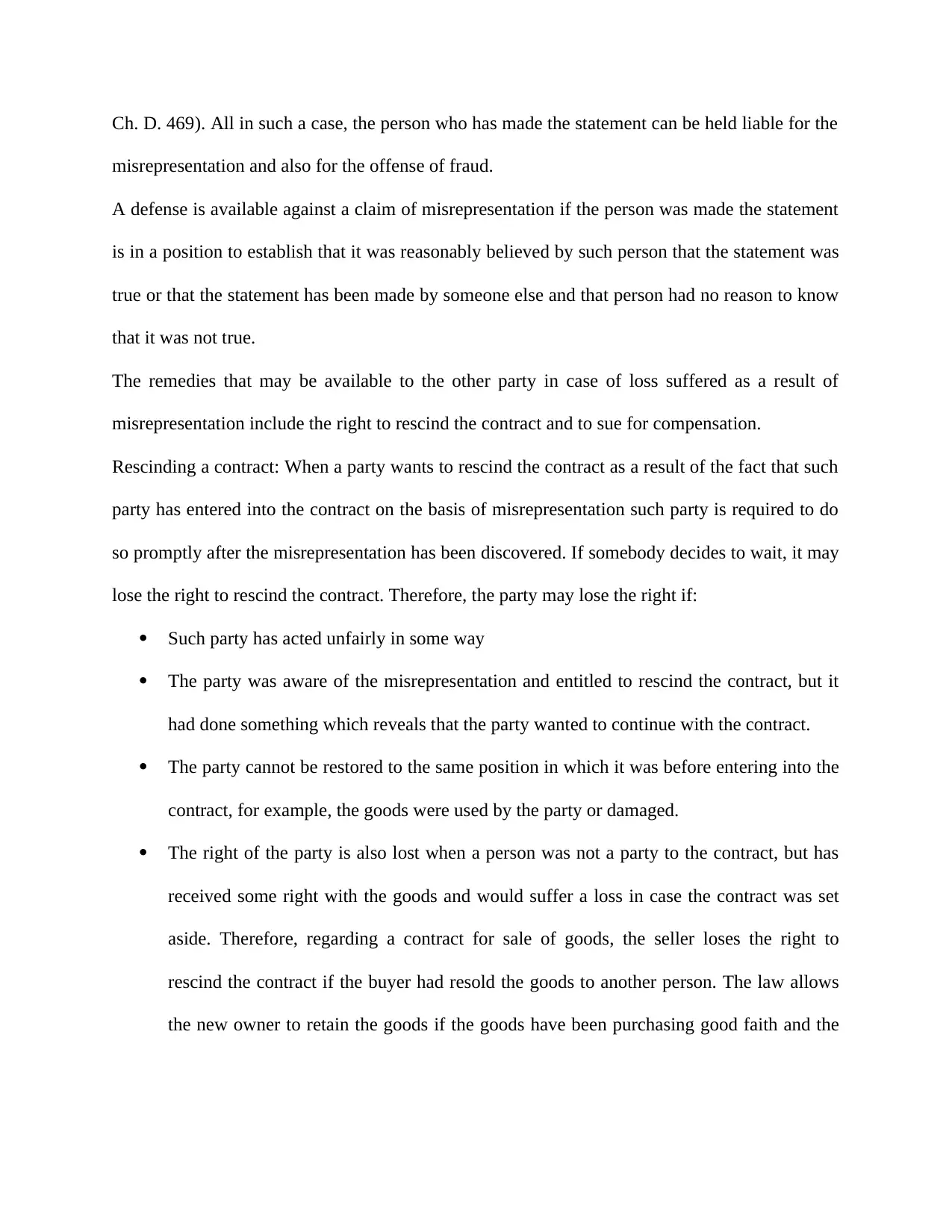
Ch. D. 469). All in such a case, the person who has made the statement can be held liable for the
misrepresentation and also for the offense of fraud.
A defense is available against a claim of misrepresentation if the person was made the statement
is in a position to establish that it was reasonably believed by such person that the statement was
true or that the statement has been made by someone else and that person had no reason to know
that it was not true.
The remedies that may be available to the other party in case of loss suffered as a result of
misrepresentation include the right to rescind the contract and to sue for compensation.
Rescinding a contract: When a party wants to rescind the contract as a result of the fact that such
party has entered into the contract on the basis of misrepresentation such party is required to do
so promptly after the misrepresentation has been discovered. If somebody decides to wait, it may
lose the right to rescind the contract. Therefore, the party may lose the right if:
Such party has acted unfairly in some way
The party was aware of the misrepresentation and entitled to rescind the contract, but it
had done something which reveals that the party wanted to continue with the contract.
The party cannot be restored to the same position in which it was before entering into the
contract, for example, the goods were used by the party or damaged.
The right of the party is also lost when a person was not a party to the contract, but has
received some right with the goods and would suffer a loss in case the contract was set
aside. Therefore, regarding a contract for sale of goods, the seller loses the right to
rescind the contract if the buyer had resold the goods to another person. The law allows
the new owner to retain the goods if the goods have been purchasing good faith and the
misrepresentation and also for the offense of fraud.
A defense is available against a claim of misrepresentation if the person was made the statement
is in a position to establish that it was reasonably believed by such person that the statement was
true or that the statement has been made by someone else and that person had no reason to know
that it was not true.
The remedies that may be available to the other party in case of loss suffered as a result of
misrepresentation include the right to rescind the contract and to sue for compensation.
Rescinding a contract: When a party wants to rescind the contract as a result of the fact that such
party has entered into the contract on the basis of misrepresentation such party is required to do
so promptly after the misrepresentation has been discovered. If somebody decides to wait, it may
lose the right to rescind the contract. Therefore, the party may lose the right if:
Such party has acted unfairly in some way
The party was aware of the misrepresentation and entitled to rescind the contract, but it
had done something which reveals that the party wanted to continue with the contract.
The party cannot be restored to the same position in which it was before entering into the
contract, for example, the goods were used by the party or damaged.
The right of the party is also lost when a person was not a party to the contract, but has
received some right with the goods and would suffer a loss in case the contract was set
aside. Therefore, regarding a contract for sale of goods, the seller loses the right to
rescind the contract if the buyer had resold the goods to another person. The law allows
the new owner to retain the goods if the goods have been purchasing good faith and the
⊘ This is a preview!⊘
Do you want full access?
Subscribe today to unlock all pages.

Trusted by 1+ million students worldwide
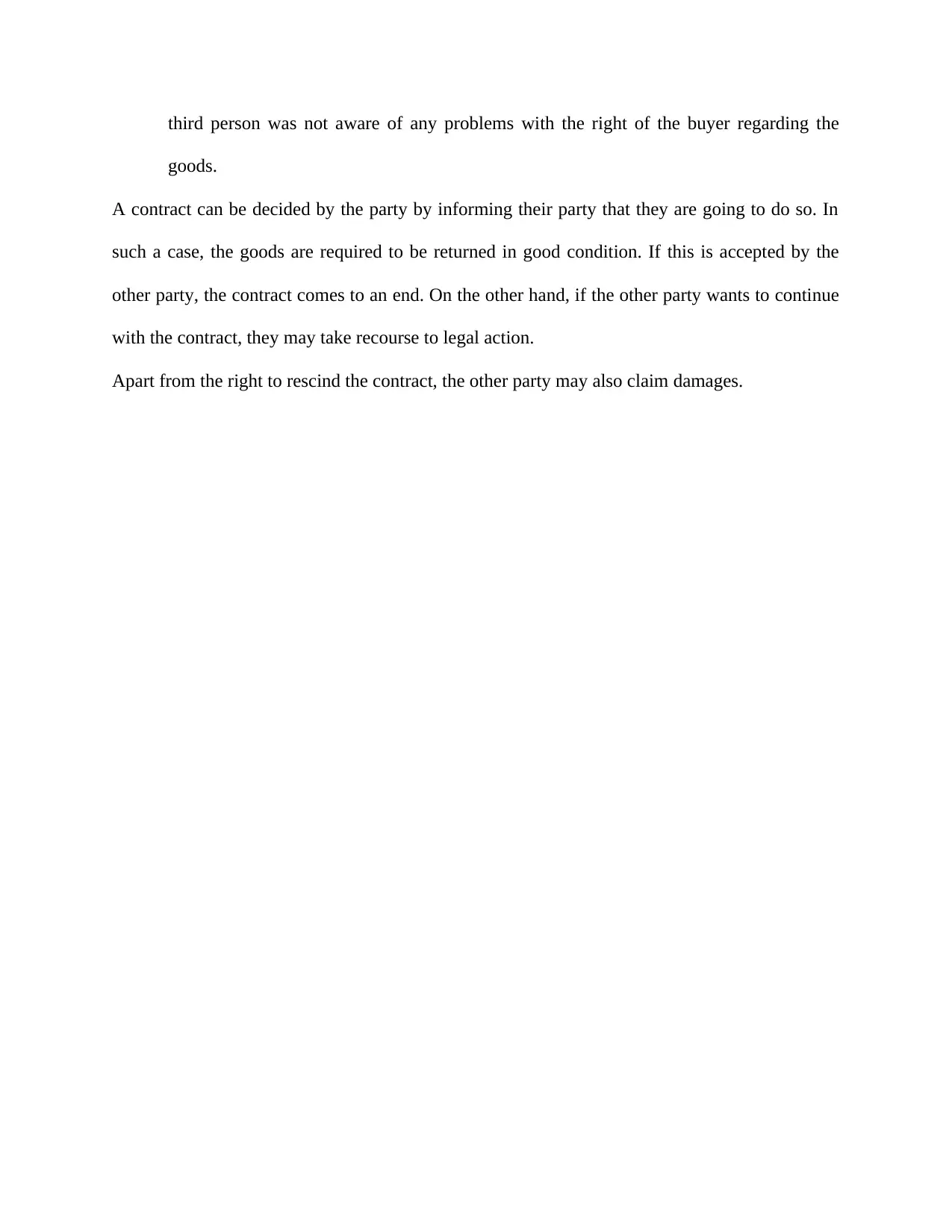
third person was not aware of any problems with the right of the buyer regarding the
goods.
A contract can be decided by the party by informing their party that they are going to do so. In
such a case, the goods are required to be returned in good condition. If this is accepted by the
other party, the contract comes to an end. On the other hand, if the other party wants to continue
with the contract, they may take recourse to legal action.
Apart from the right to rescind the contract, the other party may also claim damages.
goods.
A contract can be decided by the party by informing their party that they are going to do so. In
such a case, the goods are required to be returned in good condition. If this is accepted by the
other party, the contract comes to an end. On the other hand, if the other party wants to continue
with the contract, they may take recourse to legal action.
Apart from the right to rescind the contract, the other party may also claim damages.
Paraphrase This Document
Need a fresh take? Get an instant paraphrase of this document with our AI Paraphraser
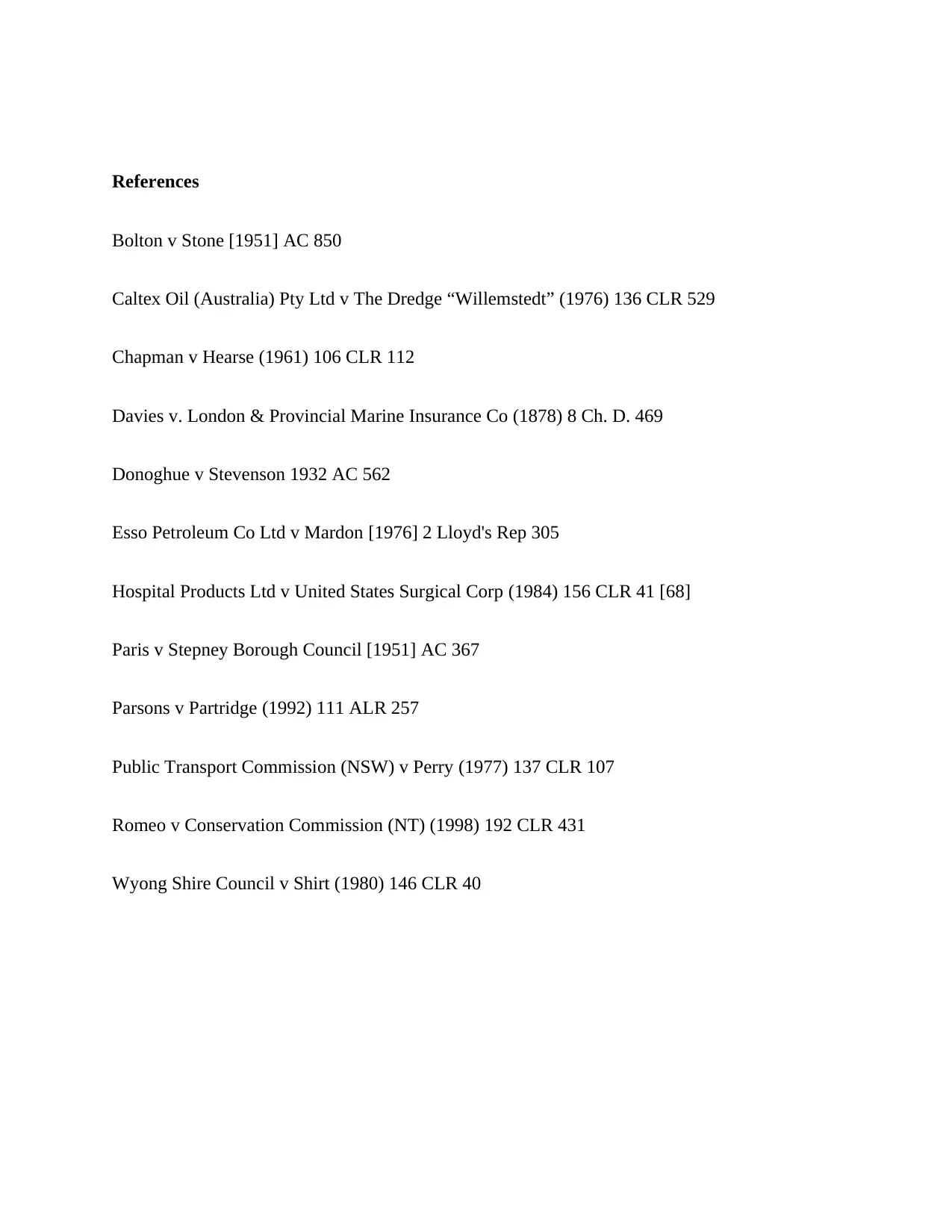
References
Bolton v Stone [1951] AC 850
Caltex Oil (Australia) Pty Ltd v The Dredge “Willemstedt” (1976) 136 CLR 529
Chapman v Hearse (1961) 106 CLR 112
Davies v. London & Provincial Marine Insurance Co (1878) 8 Ch. D. 469
Donoghue v Stevenson 1932 AC 562
Esso Petroleum Co Ltd v Mardon [1976] 2 Lloyd's Rep 305
Hospital Products Ltd v United States Surgical Corp (1984) 156 CLR 41 [68]
Paris v Stepney Borough Council [1951] AC 367
Parsons v Partridge (1992) 111 ALR 257
Public Transport Commission (NSW) v Perry (1977) 137 CLR 107
Romeo v Conservation Commission (NT) (1998) 192 CLR 431
Wyong Shire Council v Shirt (1980) 146 CLR 40
Bolton v Stone [1951] AC 850
Caltex Oil (Australia) Pty Ltd v The Dredge “Willemstedt” (1976) 136 CLR 529
Chapman v Hearse (1961) 106 CLR 112
Davies v. London & Provincial Marine Insurance Co (1878) 8 Ch. D. 469
Donoghue v Stevenson 1932 AC 562
Esso Petroleum Co Ltd v Mardon [1976] 2 Lloyd's Rep 305
Hospital Products Ltd v United States Surgical Corp (1984) 156 CLR 41 [68]
Paris v Stepney Borough Council [1951] AC 367
Parsons v Partridge (1992) 111 ALR 257
Public Transport Commission (NSW) v Perry (1977) 137 CLR 107
Romeo v Conservation Commission (NT) (1998) 192 CLR 431
Wyong Shire Council v Shirt (1980) 146 CLR 40
1 out of 8
Related Documents
Your All-in-One AI-Powered Toolkit for Academic Success.
+13062052269
info@desklib.com
Available 24*7 on WhatsApp / Email
![[object Object]](/_next/static/media/star-bottom.7253800d.svg)
Unlock your academic potential
Copyright © 2020–2025 A2Z Services. All Rights Reserved. Developed and managed by ZUCOL.





